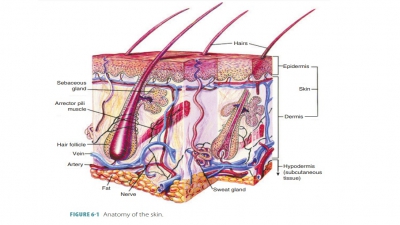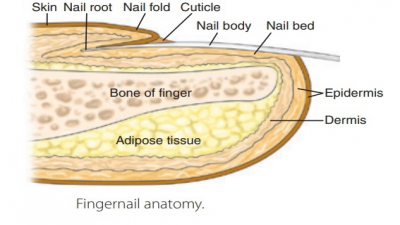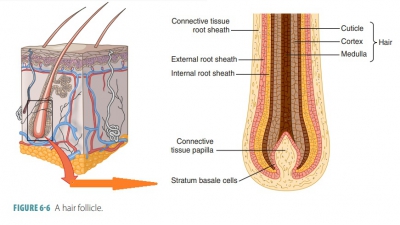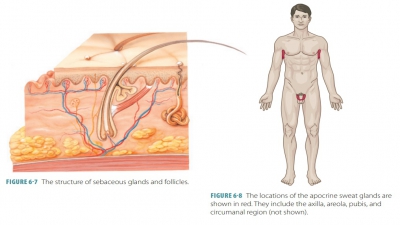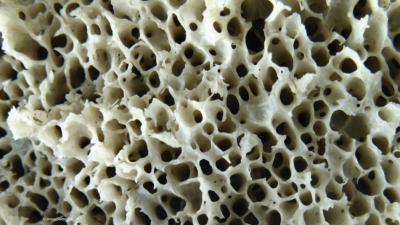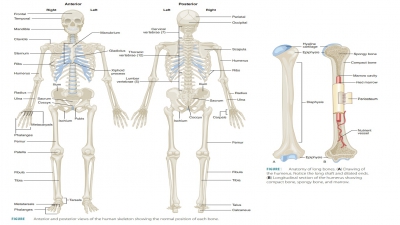Functions of the Integumentary System
| Home | | Anatomy and Physiology | | Anatomy and Physiology Health Education (APHE) |Chapter: Anatomy and Physiology for Health Professionals: Support and Movement: Integumentary System
The skin is constantly exposed to abrasion, micro-organisms, chemicals, and extremes of temperature, and has three primary barriers that protect the body: chemical, physical, and biological barriers.
Functions of
the Integumentary System
The skin is constantly exposed to
abrasion, micro-organisms, chemicals, and extremes of temperature, and has
three primary barriers that protect the body: chemical, physical, and
biological barriers.
Chemical Barriers
Chemical barriers include melanin and secretions from the skin. There are numerous types
of bacteria and other microorganisms on the skin. The low pH of skin secretions
is described as the acid mantle, which slows the multiplication of microorganisms. Many bacteria are
killed directly by contact with bac-tericidal substances from the sebum and the
dermici-din from the sweat. Defensins are natural substances secreted by skin cells that create holes in
bacteria, helping to kill them. Protective peptides or catheli-cidins are released by injured skin and are effective against many bacteria, but mostly
against group A streptococci. Also, melanin is a chemical pigment barrier
against UV light.
Physical Barriers
Physical
barriers are created by skin
continuity and hardened keratinized cells. In the stratum corneum, there
are many layers of flat, dead cells surrounded by glycolipids along with the
acid mantle and skin secre-tions to stop bacterial invasion. Water and
water-soluble substances are largely kept from diffusing between cells by the
glycolipids. Even so, a continual loss of small amounts of water occurs through
the epidermis. When the skin is immersed in water, except for salt water, it
swells slightly as it absorbs some of the water. In limited amounts, the
following substances are able to penetrate the skin: lipid-soluble substances,
oleoresins, organic solvents, heavy metal salts, certain drugs, and drug agents
known as penetration enhancers.
Lipid-soluble substances include carbon dioxide, oxygen, fat-soluble vitamins
(A, D, E, and K), and steroids such as estrogens.
Examples of oleoresins (plant resins) include poison oak and poison ivy.
Organic solvents, which dissolve cell lipids, include acetone, dry cleaning
fluids, and paint thinner. Examples of heavy metal salts include lead and
mercury. Drugs that can penetrate the skin include nic-otine, nitroglycerine,
and medications used to stop sea-sickness. Also, for at least 24 hours after
being ingested, drinks containing alcohol enhance skin permeability to a large
degree. Penetration enhancers are
drugs that help allow certain drugs to enter the body.
Biological Barriers
The body also has biological barriers that act for its
protection: the dendritic cells in the epidermis, the macro-phages in the
dermis, and the body’s DNA. Dendritic cells are active immune system components
that patrol the epidermis for antigens
(foreign substances). The dendritic cells play the same role in the epidermis
as the lymphocytes in the blood. The second line of biologi-cal barriers
consists of the dermal macrophages, which function in much the same way as the
dendritic cells. They dispose of bacteria and viruses that get past the
epidermis. DNA is a fairly potent biologic sunscreen, and its electrons absorb
UV radiation. This is trans-ferred to the nuclei of DNA atoms, causing them to
heat and vibrate quickly. The heat dissipates to nearby water molecules in an
instant. Therefore, DNA con-verts possibly harmful UV radiation into heat,
which has no negative effects in this example.
Body Temperature Regulation
As mentioned earlier, the skin is
important in regulat-ing body temperature. The deeper body parts are nor-mally
set at 98.6°F (which is equivalent to 37°C). Body heat is produced by cellular
metabolism, with most body heat being produced by the skeletal and cardiac
muscle cells as well as certain glandular cells (such as liver cells). As
temperature rises, the body is stimulated to release body heat by relaxing
dermal blood vessel walls. The eccrine sweat glands release sweat to the skin
surface, which evaporates to cool the skin. The reverse process occurs when the
body temperature drops. This holds heat in, and if the temperature continues to
drop, the body signals certain muscles to contract. Shivering is the result,
which helps to generate more body heat.
The sweat glands secrete about 17
ounces (500 mL) of sweat per day, when the body is at rest and when the
environmental temperature is below 88–90°F (31–32°C). This normal, unnoticed
sweating is described as insensible perspiration.
The sweat glands greatly increase their activity when body temperature rises
and the nervous system causes the dermal blood vessels to dilate. If the
weather is hot, sweat becomes noticeable (sensible
perspiration), accounting for up to three gallons (12 liters) of body water
loss in a sin-gle day. As the sweat evaporates, the body is cooled and
overheating is prevented. On cold days, dermal blood vessels constrict to cause
the blood to temporar-ily bypass the skin. The skin temperature assumes the
temperature of the external environment. Passive heat loss slows down, and the
body conserves heat.
Cutaneous Sensation
Sensory
receptors are located in the
dermis and are actually parts of the nervous system. They initiate nerve
impulses that can reach our conscious awareness and are classified as exteroceptors because they respond to
stimuli from outside the body. Nerve fibers in the skin control blood flow,
adjust gland secretion rates, and monitor sensory receptors in the dermis and
deeper layers of the epidermis. The epidermis also contains the exten-sion of
sensory neurons that provide sensations of pain and temperature. The dermis
contains similar receptors and other more specialized receptors (e.g.,
sensations of touch and pressure). In the dermal papillae, Meissner’s (tactile)
corpuscles and tactile discs sense
light surface touching. In the deeper
dermis or hypodermis, Pacinian or lamellar corpuscles sense harder
contacts that involve deep pressure. Even hair follicle receptors play a part
in the sense of touch. Painful stimuli are sensed by free nerve endings located
throughout the skin.
Metabolic Functions
The skin also has many metabolic
functions. It reacts to sunlight by converting modified cholesterol mol-ecules
to vitamin D precursors. These are carried by the blood to other areas of the
body for conversion to vitamin D, which aids in calcium metabolism. With-out
vitamin D, calcium could not be absorbed from the gastrointestinal tract.
Therefore, sunlight is essen-tial so the bones can absorb calcium via the
presence of vitamin D. The epidermis carries out chemical con-versions that
assist the liver. Keratinocyte enzymes play important roles related to cancer
and inflam-mation. These enzymes can either convert harmless chemicals to
carcinogens or disarm chemicals that are carcinogenic. They activate certain
steroids, such as when they transform cortisone into hydrocortisone, which has
strong anti-inflammatory properties. Other important proteins manufactured by
skin cells include collagenase, which
fights against wrinkling by stimu-lating the natural use and reuse of collagen.
Blood Reservoir
The skin also acts as a blood
reservoir and plays a role in excretion. Nearly 5% of the body’s entire blood
volume can be contained by the extensive vascular supply of the dermis. The
nervous system constricts dermal blood vessels to supply more blood to other
body organs that need this supply. More blood is moved into the general
circulation by this constric-tion, and working muscles or other organs use it.
Excretion
Nitrogen-containing wastes are
also eliminated through sweat, although most of this elimination goes through
the urine. These nitrogen-containing wastes include ammonia, urea, and uric
acid. When sweating is profuse, water and sodium chloride (salt) are lost in
large quantities.
1. What
are the three types of skin protection?
2. Explain
metabolic skin functions.
3. Describe
the chemical agents that protect the skin.
4. Why is
sunlight essential for bone health?
